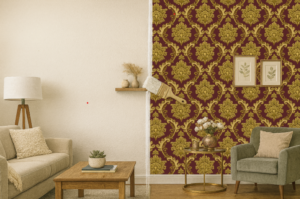Unveiling the Impact of Wallpaper Patterns on Cultural Beliefs, Available to Buy Online from Top Wallpaper Manufacturers in India!
Wallpaper has the ability to reflect and shape cultural perceptions in addition to its ornamental function. The sophisticated pattern language woven into designer wallpaper for walls serves as a silent storyteller, repeating historical histories, cultural values, and personal sentiments. Understanding how these designs impact cultural perceptions becomes an exciting inquiry into the interplay between art, culture, and identity as people seek to buy wallpaper for walls online from Leading manufacturers in India.
The Pattern Language: How Wallpaper Design Influences Cultural Perceptions
Wallpaper design goes beyond conventional aesthetics to convey societal narratives, historical legacy, and cultural identities. Wall patterns communicate a language that represents community values, traditions, and aspirations, creating and perpetuating cultural perceptions over generations.
Patterns have great meanings and significance in many civilizations around the world. Floral motifs, for example, may represent growth, beauty, and vitality in some cultures, but geometric forms may represent spirituality, order, or ties with the divine. Understanding these symbolic links is essential for deciphering the layered cultural complexity weaved into wallpaper designs.
Cultural values have an unmistakable influence on wallpaper design. The vivid and intricate patterns of paisleys, mandalas, or traditional motifs, for example, reflect India’s rich heritage, spirituality, and meaning. These designs, which are frequently found in designer wallpapers for walls, go beyond basic adornment, acting as a link between historical traditions and present expressions of cultural identity.
Furthermore, wallpaper designs frequently depict migration, trading routes, and historical interactions between civilizations. Patterns crossed borders, bearing stories of conquests, artistic partnerships, and the synthesis of various cultural aspects. This historical context embedded in wallpaper designs adds to the various cultural tapestries seen in current houses.
Wallpaper designs are interpreted differently across cultures, reflecting the subjective aspect of perception. What is a lucky symbol in one culture may have very different connotations in another. The juxtaposition of different patterns inside spaces also symbolizes cultural syncretism, demonstrating the blending of traditions and beliefs.
Designers and wallpaper makers play an important role in reworking classic patterns in current times, integrating modern interpretations that pay attention to cultural heritage while connecting with growing tastes. This progress achieves a difficult balance between legacy preservation and the embrace of innovation.
The opportunity to buy wallpaper for walls online from prominent manufacturers in India provides users with a blank canvas on which to explore and combine numerous cultural influences. Through intelligently curated interiors, it is possible to appreciate variety, honor traditions, and demonstrate ethnic pride.
Wallpaper Design’s Cultural Evolution and Adaptation


Wallpaper design evolves over time to represent the dynamic of cultural values and societal changes. Patterns that were formerly associated with certain places or eras have crossed continents, altered, and transformed into modern expressions that appeal to a worldwide audience.
The influence of Eastern aesthetics on Western wallpaper design, for example, represented an era of interest with oriental patterns, motifs, and themes in the 18th and 19th centuries. This cross-cultural contact produced hybrid designs that fused Eastern complexities with Western sensibilities, forming a new visual language.
In addition, colonial expansion and worldwide commerce routes encouraged the exchange of ideas and design components, which influenced wallpaper patterns. The inclusion of exotic flora, animals, and cultural symbols from distant locations into wallpapers reflected civilizations’ connectivity, increasing cultural appreciation and intrigue.
Modernism and other twentieth-century design movements resulted in a trend toward minimalism and abstraction in wallpaper design. Nonetheless, cultural influences persisted even within minimalist aesthetics. Geometric designs were inspired by traditional themes but in more stylized and modern shapes.
A renaissance of interest in traditional handicrafts and indigenous artwork has resulted in a resurgence of cultural motifs in wallpaper design in recent years. Artists and designers are rediscovering ancient patterns and infusing them with fresh interpretations that pay homage to the past while also catering to modern tastes.
Furthermore, digital technology has broadened the range of wallpaper design options. Artists and manufacturers may now use accuracy and detail to produce intricate, culturally inspired designs, allowing for a seamless marriage of history and innovation.
Color palettes are also influenced by cultural views in wallpaper design. Colors have different meanings in different cultures, which influences how they are used in wallpaper. For example, while red may represent luck and prosperity in some cultures, it may also represent danger or warning in others, influencing its depiction in designs.
Eclecticism is commonly celebrated in contemporary interior design, emphasizing the juxtaposition of many cultural influences within rooms. This eclectic approach reveals itself in the stacking of different pattern wallpapers or the integration of global design influences, resulting in visually stimulating and culturally diverse rooms.
Contemporary Interpretations of Cultural Narratives


In wallpaper design, the convergence of traditional tales and contemporary interpretations provides an intriguing view into how traditions change and adapt to modern sensibilities. Designers currently use ethnic motifs, folklore, and indigenous art forms to create wallpapers that appeal to a wide range of consumers.
The reworking of old patterns in a new context is one significant tendency. Classical motifs are frequently infused with strong colors, geometric abstraction, or minimalist techniques by designers, giving fresh life to age-old designs while keeping their cultural essence.
Furthermore, the appreciation of cultural diversity has resulted in a desire for wallpapers honoring distinct heritages. Wallpapers with intricate mandalas inspired by Eastern ideas or themes taken from African tribal art, for example, are becoming increasingly popular due to their distinct aesthetic and cultural value.
Wallpaper patterns represent the importance of narrative in cultural heritage. Some wallpapers tell stories from folklore, mythology, or history, encapsulating rich narratives inside patterns that cover walls and enabling viewers to interact with these stories.
The online availability of wallpapers from many cultures has encouraged a global flow of design inspirations. Homeowners can now create areas that reflect their ethnic identities or pay homage to other customs, promoting inclusion and appreciation for cultural variety.
Furthermore, collaborations between designers and local craftspeople or indigenous groups frequently result in wallpapers that not only highlight cultural aesthetics but also promote traditional handicrafts and local economies.
Simultaneously, wallpaper design has evolved into a platform for social commentary and cultural research. Some modern wallpapers address societal issues, cultural identities, or environmental concerns, stimulating dialogue and contemplation within interior spaces.
The language of patterns in wallpaper design continues to transcend borders as we navigate an increasingly interconnected globe, allowing glimpses into the rich fabric of human experiences, beliefs, and aspirations.
Finally, the incorporation of cultural inspirations into contemporary wallpaper design symbolizes a lovely marriage of tradition and innovation. It exemplifies the enduring history of cultural narratives, recreated and communicated via patterns that adorn our walls, urging us to study, celebrate, and appreciate the richness of human heritage.
Follow the Eximus website and YouTube channel, or head to our social media platforms like Facebook, Instagram! or Call us on tel:+918828151202




